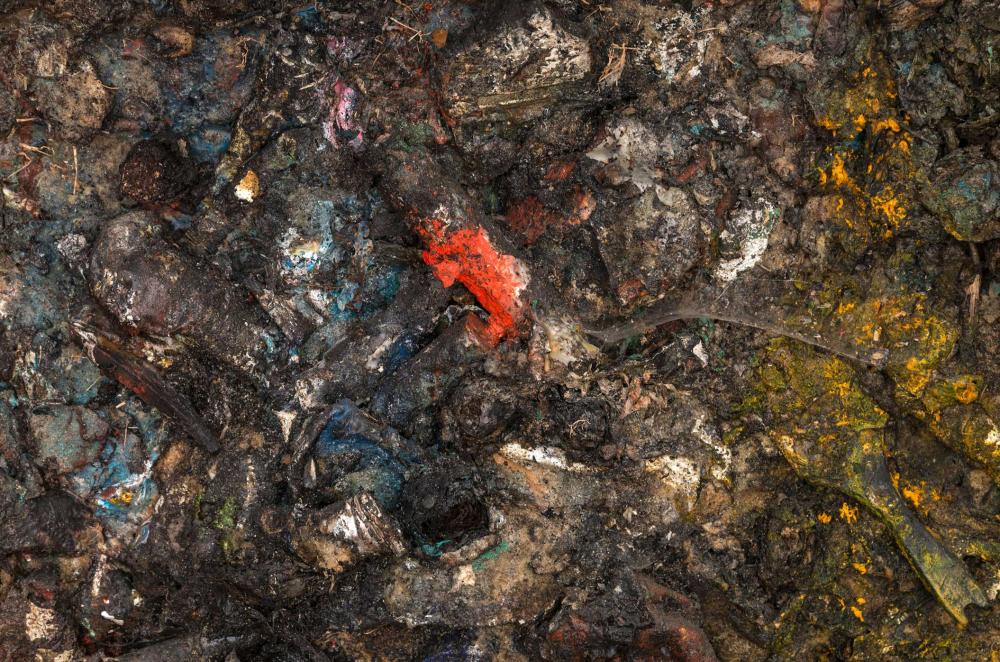A Golem that Ended Well
Article in the Exhibition Catalogue GOLEM
Emily D. Bilski
Over a period of nearly four decades, Michael David has returned again and again to the Golem legend as subject and inspiration: in a series of powerful and controversial swastika-shaped canvases; in self-portraits, in photography; in mixed-media works that push the boundaries of what constitutes painting.
David’s use of the encaustic medium—mixing pigment with hot beeswax—has become a hallmark of his art, a technique that he finds analogous to the legendary methods of golem making, which employed wax, dirt, clay and fire. For the artist personally, the technique itself proved to be a golem: he was poisoned by toxic gasses that were released in the heating process involved in working with encaustic, leaving him partially paralyzed. After intensive rehabilitation, he was able to return to painting, though some impairment remains. Making art, like making golems, can be dangerous, yet artists and golem makers continue to take risks. The transcendental nature of making art, and the compulsion that artists feel to create, is akin to the longing of the mystics for connection with the divine, which motivates them to make golems. David’s A Cluster of Blessings, in its imagery and the process of its creation, embodies both the transcendent and destructive aspects of golem making. David took the work’s title from the Buddhist writings of Nichiren Daishonin, who in a 1280 letter characterized Enlightenment as “the place of the cluster of blessings where the Buddhas and bodhisattvas dwell.”
The supporting panel was created from older works, which he pieced together and repurposed. To create its animated surface, David affixed an accretion of items that reflect ten years of his studio practice, including old paint tubes, rags, brushes, sticks, work clothes and flowers brought by his students from their gardens over the course of a year. Pouring paint, wax and resin over the surface unified these disparate elements.
Later, David and some friends subjected the work to burning, a fire that raged out of control and, inadvertently, nearly consumed the work, like a golem run amok. Finally, the work was left in a field for a year, exposed to the vagaries of nature. Each of these processes involved a transformation of materials in the service of creating a work that is, for the artist, both golem and “anti-golem,” defined by the artist as “a golem that ended well.”
One could interpret the blessings alluded to in the work’s title as those accrued by David over years of productive work, as artist, teacher and mentor, bolstered by a supportive community. Though its ashen surface suggests death, as with forest fires that ultimately clear the way for new generations of trees, signs of rebirth peak through in the brilliant patches of yellow and orange hue. Subject and process are unified here. David’s work, like the story of the golem, is transformation incarnate. A Cluster of Blessings was created from materials that have been transformed by fire and nature, but ultimately by the artist’s hand, eye and intellect.
Emily D. Bilski is an art historian, the main focus of her work is the interface between art, cultural history, and the modern Jewish experience as well as contemporary art. She works as a curator and counselor for museums in the United States, Europe, and Israel. Her books Berlin Metropolis: Jews and the New Culture: 1890-1918 (1999) and Jewish Women and Their Salons: The Power of Conversation (2005) were both awarded the National Jewish Book Award.
 X
X
A Cluster of Blessings (The Golem)
Michael David, USA, 2008–2015
Oil, wax, resin, dirt, wire, flowers on wood, 182.88 x 243.84 cm
Citation recommendation:
Emily D. Bilski (2016), A Golem that Ended Well. Article in the Exhibition Catalogue GOLEM.
URL: www.jmberlin.de/en/node/4695

Online Edition of the GOLEM Catalog: Table of Contents
- Landing Page
- The Golem in Berlin: Introduction by Peter Schäfer
- Chapter 1
- The Golem Lives On: Introduction by Martina Lüdicke
- My Light is Your Life: Text by Anna Dorothea Ludewig
- Avatars: Text by Louisa Hall
- The Secret of the Cyborgs: Text by Caspar Battegay
- Chapter 2
- Jewish Mysticism: Introduction by Emily D. Bilski
- Golem Magic: Text by Martina Lüdicke
- Golem, Language, Dada: Text by Emily D. Bilski
- Chapter 3
- Transformation: Introduction by Emily D. Bilski
- Jana Sterbak’s Golem: Objects as Sensations: Text by Rita Kersting
- Crisálidas (Chrysalises): Text by Jorge Gil
- Rituals: Text by Christopher Lyon
- Current page: A Golem that Ended Well: Text by Emily D. Bilski
- On the Golem: Text by David Musgrave
- Louise Fishman’s Paint Golem: Text by Emily D. Bilski
- Chapter 4
- Legendary Prague: Introduction by Martina Lüdicke
- Golem Variations: Text by Peter Schäfer
- Rabbi Loew’s Well-Deserved Bath: Text by Harold Gabriel Weisz Carrington
- Chapter 5
- Horror and Magic: Introduction by Martina Lüdicke
- Golem and a Little Girl: Text by Helene Wecker
- The Golem with a Group of Children Dancing: Text by Karin Harrasser
- Bringing the Film Set To Life: Text by Anna-Carolin Augustin
- Golem and Mirjam: Text by Cathy S. Gelbin
- Chapter 6
- Out of Control: Introduction by Emily D. Bilski
- Golem—Man Awakened with Glowing Hammer: Text by Arno Pařík
- Dangerous Symbols: Text by Charlotta Kotik
- Be Careful What You Wish For: Text by Marc Estrin
- Chapter 7
- Doppelgänger: Introduction by Martina Lüdicke
- From the Golem-Talmud: Text by Joshua Cohen
- Kitaj’s Art Golem: Text by Tracy Bartley
- The Golem as Techno-Imagination?: Text by Cosima Wagner
- See also
- GOLEM: 2016, online edition with selected texts of the exhibition catalog
- GOLEM: 2016, complete printed edition of the exhibition catalog, in German
- Golem. From Mysticism to Minecraft: Online Feature, 2016
- GOLEM: Exhibition, 23 Sep 2016 to 29 Jan 2017


